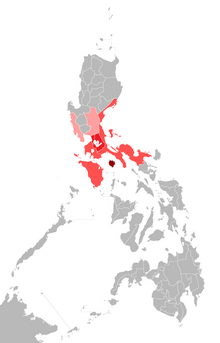Tagalog language
| Tagalog | |
|---|---|
| Wikang Tagalog | |
| Pronunciation | [tɐˈɡaːloɡ] |
| Native to | Philippines |
| Region | Central and Southern Luzon |
| Ethnicity |
Tagalog people Filipino Americans Filipino Canadians Filipinos in Palau |
|
Native speakers
|
28 million (2007) 45 million L2 speakers (2013) Total: 70+ million |
|
Early forms
|
Proto-Philippine
|
|
Standard forms
|
|
| Dialects |
|
|
Latin (Tagalog/Filipino alphabet), Philippine Braille Historically Baybayin |
|
| Official status | |
|
Official language in
|
Regional and official in the Philippines (in the form of Filipino) |
| Regulated by | Komisyon sa Wikang Filipino |
| Language codes | |
| ISO 639-1 | tl |
| ISO 639-2 | |
| ISO 639-3 |
Individual code: fil – Filipino |
| Glottolog |
taga1280 (Tagalogic)taga1269 (Tagalog/Filipino)
|
| Linguasphere | 31-CKA |

Predominantly Tagalog-speaking regions in the Philippines. The color-schemes represent the 4 dialect zones of the language: Northern, Central, Southern, and Marinduque The majority of residents in Camarines Norte and Camarines Sur speak Bikol as their first language but these provinces nonetheless have significant Tagalog minorities. In addition, Tagalog is used as a second language across the Philippines.
|
|
Tagalog (/təˈɡɑːlɒɡ/;Tagalog pronunciation: [tɐˈɡaːloɡ]) is an Austronesian language spoken as a first language by a quarter of the population of the Philippines and as a second language by the majority. Its standardized form, officially named Filipino, is officially the national language, along with English.
It is related to other Philippine languages, such as the Bikol languages, Ilocano, the Visayan languages, Kapampangan and Pangasinan, and more distantly to other Austronesian languages, such as the Formosan languages, Indonesian and Malay, Hawaiian, Malagasy and Māori.
The word Tagalog is derived from the endonym taga-log ("river dweller"), composed of tagá- ("native of" or "from") and ilog ("river"). Linguists such as Dr. David Zorc and Dr. Robert Blust speculate that the Tagalogs and other Central Philippine ethno-linguistic groups originated in Northeastern Mindanao or the Eastern Visayas.
...
Wikipedia
